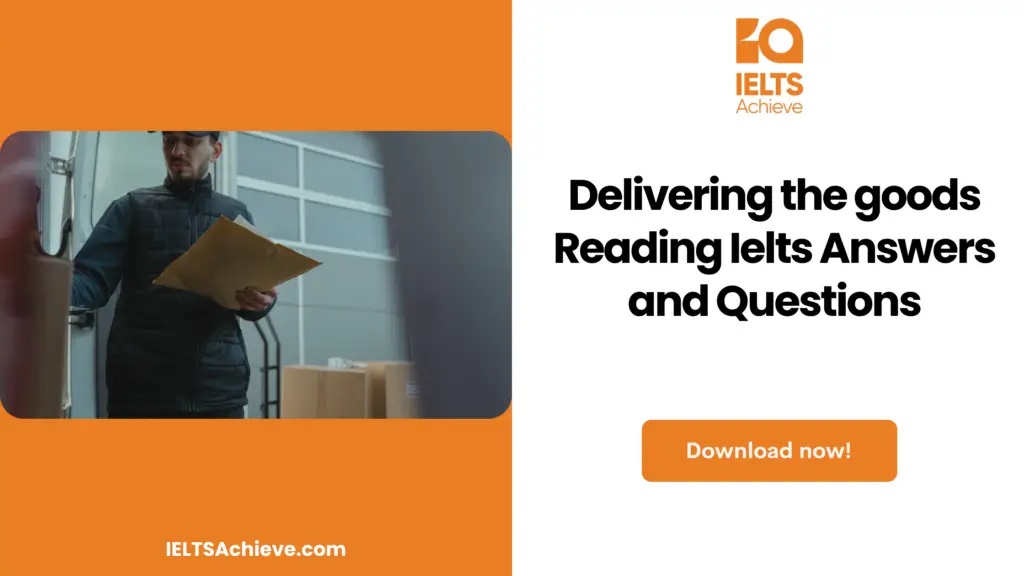The Blog post contains the following IELTS Reading Questions:
- IELTS reading locating information
- IELTS reading true/false/not given
- IELTS reading summary completion
Stay informed and prepared for success – Explore our comprehensive Reading Test Info page to get valuable insights, exam format details, and expert tips for mastering the IELTS Reading section.
IELTS reading passage – Delivering the goods

Delivering the goods
The vast development of global trade owes greatly to a revolution in the movement of goods
International trade is increasing at an incredible rate. As the world economy expands by more than 3% a year, the volume of trade is doubling at a compound annual pace. Foreign commodities, from meat to machinery, play a vital role in every economy of the world, and foreign markets are now encouraging businesses that are less concerned about sales beyond their own borders.
What is behind this explosion in international trade? The general global drop in trade sanctions such as customs responsibilities and import quotas is definitely an explanation. The financial start of countries that have traditionally been small players is another. But a force behind the import-export boom, the rapidly dropping price of transporting goods to market, has passed unnoticed. Theoretically, in the business world, shipping charges are not a bar. Goods are assumed to move from place to place as soon as they are made, without cost. However, the whole world is full of friction. Cheap labour can make Chinese clothing more competitive in the United States, but if delays in exports build-up current capital and bring winter coats into the spring, trade could lose its benefits.
At the beginning of the 20th century, agriculture and production were the two most vital sectors almost everywhere, accounting for about 70% of GDP in Germany, Italy, and France and 40-50% in the United States, Britain, and Japan. Thus global trade was dominated by raw materials such as wheat, wood, and iron ore or processed products such as meat and steel. But these types of items are heavy and bulky and the expense of carrying them is relatively high.
Countries still trade in proportion with their geographical neighbours. Yet, over time, global output has become a commodity whose value is irrelevant to its size and weight. Today, finished products dominate the trade flow, and thanks to technological advances such as lightweight components, manufactured products themselves become lighter and less bulky. As a consequence, less than one dollar worth of imports or exports is needed for transportation.
To notice how this affects business, think about the business of creating disk drives for computers. Most disk drive production around the globe is focused in Southeast Asia. This is only viable because disk drives are valuable but little and lightweight and low-cost to ship. If computer manufacturers in Japan or Texas import drive from Singapore instead of buying them in the domestic market, they will not face large freight rates. Thus, distance is not a barrier to the globalisation of the disk drive industry.
This is even more correct in the quick-growing information industries. Films and compact discs are less expensive to carry even on an aeroplane. Computer software can be ‘exported’ without being shipped, and by sending telephone links from one country to another, shipment paces and inventory-handling tables are important factors in determining where the product is manufactured. Businesses can find out based on other concerns such as labour availability while being less concerned about the cost of delivering their output.
In many countries, deregulation has aided to drive the process. But behind the scenes, a series of technical innovations, widely known as containerization and intermodal transportation, led to fast productivity advancements in cargo handling. Forty years ago, the export or import process involved many stages of handling so that parts of the ship could be damaged or stolen along the way. The invention of the container crane made it possible to load and unload containers without capsizing, and the acceptance of common container sizes permitted any container to be carried on any vessel. By 1967, dual-purpose ships were loading loose cargo and deck containers, leading to all container ships moving thousands of boxes at once.
Ship Container has transformed marine shipping into a highly efficient, extremely competitive business. But the arrival of cargo at the dock is a separate story. National governments, by and large, had a much stronger hand on truck and rail fares than on freight. However, this began to change in the mid-1970s, when the United States began to regulate its transportation industry. First the airlines, then the road hauliers and the railways, were released from the restrictions of what they could carry, where they could be towed, and what they could charge. For instance, between 1985 and 1996, freight railways in the United States dramatically lowered their employment and tracks, while raising the amount of freight they carried. Europe’s railways, though small, have shown progress in productivity.
In the United States, the period of great productivity profits in transportation may be almost over, but in most countries, this method still has a long way to go. The state ownership of railways and airlines, the regulation of freight rates, and the tolerance of anti-competitive practices such as freight handling monopolies all keep shipping costs unnecessarily high and prevent international trade. Reducing these barriers will help global economies develop even closer.
Unlock your full potential in the IELTS Reading section – Visit our IELTS Reading Practice Question Answer page now!
Recommended Questions:
Renewable Energy IELTS Reading Question with Answer
Delivering the goods IELTS reading questions
Question (1-5)
This reading passage has nine paragraphs, A–I. Which paragraph contains the following information? Write the correct letter, A-I, as your answer to each question. Note: You may use any letter more than once.
1. Agriculture and production were the two most vital sectors almost everywhere.
2. The volume of trade is doubling at a compound annual pace as the world economy expands by more than 3% a year.
3. The financial start of countries that have traditionally been small players is another.
4. Cheap labour can make Chinese clothing more competitive in the United States.
5. Foreign markets are now encouraging businesses that are less concerned about sales beyond their own borders.
Question (6 – 9)
Do the following statements agree with the information given in the Reading Passage? Write
- TRUE if the statement agrees with the information
- FALSE if the statement contradicts the information
- NOT GIVEN if there is no information on this
6. Global output has become a commodity whose value is irrelevant to its size and weight.
7. More than one dollar worth of imports or exports is needed for transportation.
8. Mini computer and laptop components are made in Germany.
9. Distance is a barrier to the globalisation of the disk drive industry.
Enhance your skills in identifying information as True, False, or Not Given. Click here to discover expert strategies and techniques for mastering this question type in the IELTS Reading section.
Question (10 – 13)
Complete the summary below.
Write NO MORE THAN TWO WORDS from the passage for each answer.
10 __________ and compact discs are less expensive to carry even on an aeroplane. Businesses can find out based on other concerns such as labour availability while being less concerned about the 11 ________ of delivering their output. The export or import process involved many stages of handling so that parts of the ship could be damaged or stolen along the way, 12 ____________ ago. Europe’s railways, though small, have shown progress in 13 ______________.
Unlock your full potential in the IELTS Reading section – Visit our IELTS Reading Practice Question Answer page now!
Recommended Questions:
Renewable Energy IELTS Reading Question with Answer
Delivering the goods IELTS reading answers
1. Paragraph C
2. Paragraph A
3. Paragraph B
4. Paragraph B
5. Paragraph A
6. Yes
7. No
8. Not Given
9. No
10. Films
11. cost
12. Forty years
13. productivity

We hope you found this post useful in helping you to study for the IELTS Test. If you have any questions please let us know in the comments below or on the Facebook page.
The best way to keep up to date with posts like this is to like us on Facebook, then follow us on Instagram and Pinterest. If you need help preparing for the IELTS Test, join the IELTS Achieve Academy and see how we can assist you to achieve your desired band score. We offer an essay correction service, mock exams and online courses.

